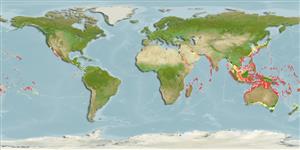Preferred temperature (ເອກະສານອ້າງອີງ
123201): 24.1 - 28.9, mean 27.5 °C (based on 802 cells).
Phylogenetic diversity index (ເອກະສານອ້າງອີງ
82804): PD
50 = 0.5000 [Uniqueness, from 0.5 = low to 2.0 = high].
Bayesian length-weight: a=0.00617 (0.00288 - 0.01322), b=3.04 (2.86 - 3.22), in cm total length, based on LWR estimates for this (Sub)family-body shape (Ref.
93245).
ຊັ້ນເຂດຮ້ອນ (ເອກະສານອ້າງອີງ
69278): 3.4 ±0.45 se; based on food items.
ຄວາມຢືດຢຸ່ນ (ເອກະສານອ້າງອີງ
120179): ສູງ, ປະຊາກອນຕຳ່ສຸດທີ່ໃຊ້ເວລາສອງໜ້ອຍກວ່າ 15 ເດືອນ (Preliminary K or Fecundity.).
Fishing Vulnerability (Ref.
59153): Low vulnerability (10 of 100).
🛈
Nutrients (Ref.
124155): Calcium = 433 [156, 1,848] mg/100g; Iron = 2.47 [0.83, 5.79] mg/100g; Protein = 18.1 [16.2, 19.9] %; Omega3 = 0.108 [0.024, 0.510] g/100g; Selenium = 89.7 [15.6, 432.6] μg/100g; VitaminA = 35 [4, 270] μg/100g; Zinc = 5.59 [2.35, 10.78] mg/100g (wet weight);
